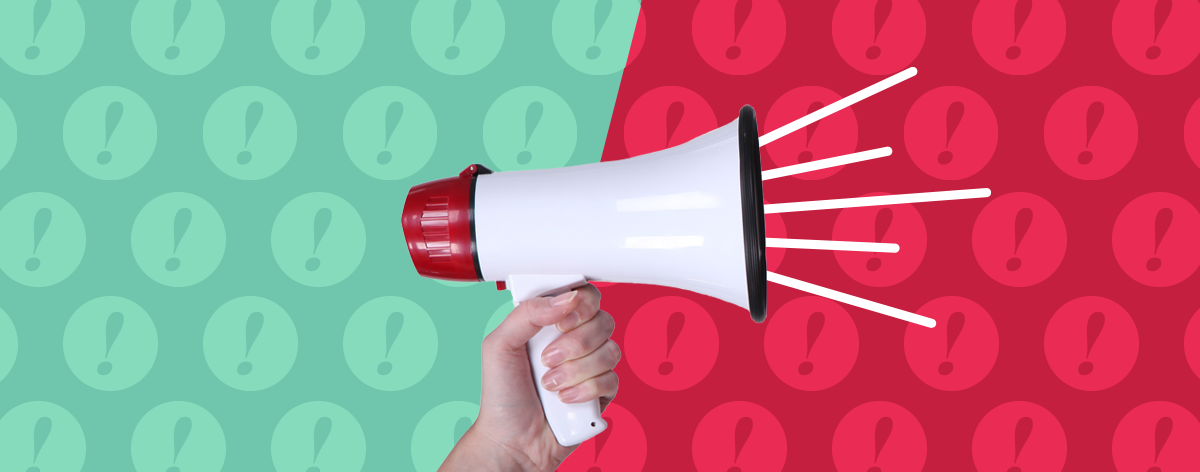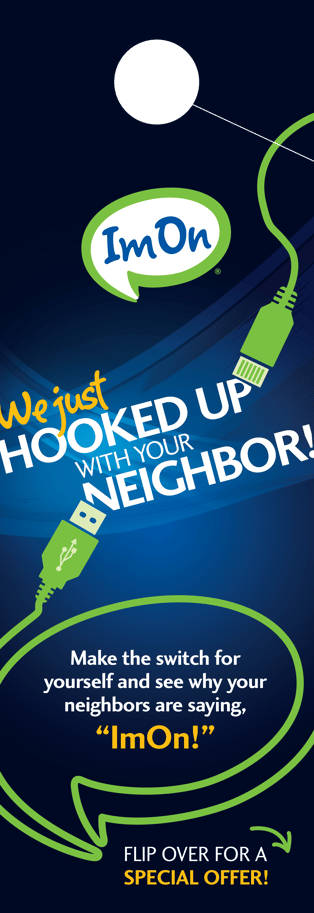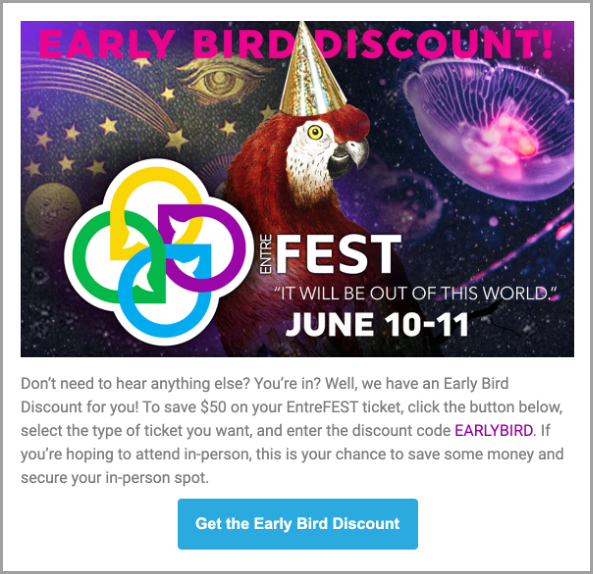Steve Maxfield

THE IMPORTANT FIRST STEP
Time, resources and budget all go into your marketing plan and materials. The best way to optimize all that work you’ve put in is making sure they grab attention.
In one ear, out the other... Probably got lost among the unread emails in my inbox... Must have missed that one... These are all potential audience responses and actions to your marketing efforts that need to be addressed in the early stages of brainstorming and planning.
There are boatloads of ways (like dozens and dozens and dozens of cargo ships) to grab a viewer’s attention and this blog is a way to help you decide the right way to do that.
METHODS OF ATTENTION GRABBING
Here are three proven approaches you can take to help you stand out amongst the sea of advertising your viewers take in each day. These approaches won’t necessarily require putting tons more time, resources, or budget into the marketing plan.
USING HUMOR
There are many different ways to effectively use humor in order to grab a viewer’s attention. Even if humor isn’t part of your brand’s voice and tone, it can still be added to the mix. Be careful not to lose touch with the message you’re trying to get across though. Overuse of humor in marketing materials can become a problem, similar to the tragic “all caps subject lines” trend.
Good Example

How many times have you come home, seen a promotional door hanger on your front door, and just thrown it away without even reading it? de Novo used humor to create this attention-grabbing door hanger for ImOn Communications, which let residents know when their neighbors switched internet providers.
GETTING TO THE POINT
Customer: “I’m in need of coffee”
Company: “Perfect, we sell coffee”
Customer: “Wonderful, I’ll buy some now”
Company: “Deal!”
Unfortunately, conversations like this aren’t typically how revenue comes in. However, there’s still an important lesson to take from this fictitious conversation—it’s ok to be direct and get right to the point. After all, the audience you want to reach likely has an interest or need and you are here to provide it.
For example, if you’re hosting an event, it’s ok to announce that event in your promotional email and use the subject line, “Event A registration is now open.” That’s valid information for your audience to see!
*Side note—any viewer that opens that promo email probably has genuine interest in the event and should be followed up with.
Careful not to be too broad with your direction though. “Buy Now” won’t always resonate with viewers if they don’t know what they’re buying, why they should buy it, or have never heard from your company or organization before. Always remember to keep your audience in mind (who the audience is and what’s their relationship to you) when using this approach.
Good Example

Hanna Plumbing & Heating gets straight to the point with this digital ad. Spring melt causes a lot of headache for us in the Midwest, especially if a sump pump isn’t ready to handle it (a lot of de Novians have learned this the hard way). This ad asks a clear question and gives a specific direction to take based on how a viewer answers the question.
INCENTIVIZE!
This is a classic approach to grabbing the attention of viewers, and often the little shove they need to take the action you’re driving them toward. Having a tangible representation can have direct influence on your audience’s mindset. Sort of like going from “I’m going to delete this email with the rest of the promotions I’m not going to read” to “Oh wait, what’s this tangible incentive? Maybe I’ll open that one and see.”
Incentivizing shouldn’t create tons and tons of work on top of the campaign you’re putting together—you just need to connect the dots. For example, if someone fills out a form with their information, will they get something in return like an e-book or promo code? Emphasize what comes next or what your audience will get out of the transaction.
Good Example

EntreFEST offers an early bird discount to all attendees who register within a specific time frame prior to the event. See how they get straight to the point in this email. Chances are if you’re interested in attending EntreFEST you’ll register in time for the discounted price.
FIRST IMPRESSIONS ARE IMPORTANT
Leaving a good first impression in a marketing campaign is kind of like leaving one for a new teacher on the first day of school. You want to show that you’re intelligent, hard-working, kind, respectful, and you want to get just the right amount of attention from teach. Let’s look at some of the first campaign content your audience’s eyes are going to see and make sure you’re leaving the best first impression.
EMAIL SUBJECT LINES & PREHEADERS
Close your eyes and imagine an inbox full of unread emails. Now open your eyes. How are you going to use your marketing email's subject line and preheader to jump out and grab attention? That’s the process you should use for each subject line and preheader that you decide to use.
- Make sure to keep the subject lines relevant to the audience.
- The fewer words the better—but don’t be afraid to use a few extra if it makes the information easier to digest.
- Are the subject line and preheader cohesive? Are they relevant to the actual content in the email? Both answers should be "yes."
ENVELOPES
Envelopes are basically the subject lines of actual mailboxes. They are the gateway to the content and the first thing a consumer sees from an organization. Therefore, we’re going to practice the same drill. Close your eyes and imagine yourself opening the mailbox when you get home from a long day of work. It’s filled with letters, flyers, bills, etc. Now open your eyes. How are you going to make your envelope containing the valuable content you’ve spent so much time on stand out from the rest? That’s the process you should use for the envelope instead of thinking of it as an afterthought.
“What if the direct mail piece I’m sending doesn’t include an envelope?”
The same attention-grabbing approach should be and can easily be considered when designing a postcard, brochure, or flyer that won't need to be sealed in an envelope.
DIGITAL ADS
When it comes to digital advertising, the first impression is the only impression you get a chance to make. Here’s a few questions you should ask yourself before releasing your ad into the crowded world-wide web.
- Will your ad stand out enough to catch a viewer’s eye as they are scrolling through a website or their social media accounts?
- Does your ad clearly make its point within 5 seconds of grabbing the viewers eye?
- Do you think the viewer will recognize your brand moving forward even if they don’t click on the ad? In other words, do you think you’ve accomplished brand recognition as a secondary goal?
CONVERTING THE ATTENTION ONCE YOU'VE GRABBED IT
You’ve got the attention of a viewer! They opened your promo email. They clicked on your digital ad. They tore open the envelope of the print piece you sent them. What now?
WHAT'S THE CTA?
Whatever your call-to-action is, it’s time to focus the attention to that. You have the viewers’ attention now, but you won’t have it for long if they don’t understand what they’re viewing right away. Make sure your CTA is clear and can be identified right away by viewers.
FOLLOW UP WITH THE MAYBES
Grabbing attention but then losing it isn’t necessarily a lost cause. If someone takes any steps beyond the initial engagement of a marketing piece (clicking further into an email or on your website, liking or sharing something on social media, etc.) but doesn’t necessarily fulfill the CTA, don’t forget to follow up with them. That is a lead with genuine interest!
If you enjoyed this, you should probably, but definitely check out the blogs below and continue to expand your marketing approach!
- 6 Questions You Should Ask About Your Marketing Content
- Sometimes You Need a Creative Escape




Submit a Comment